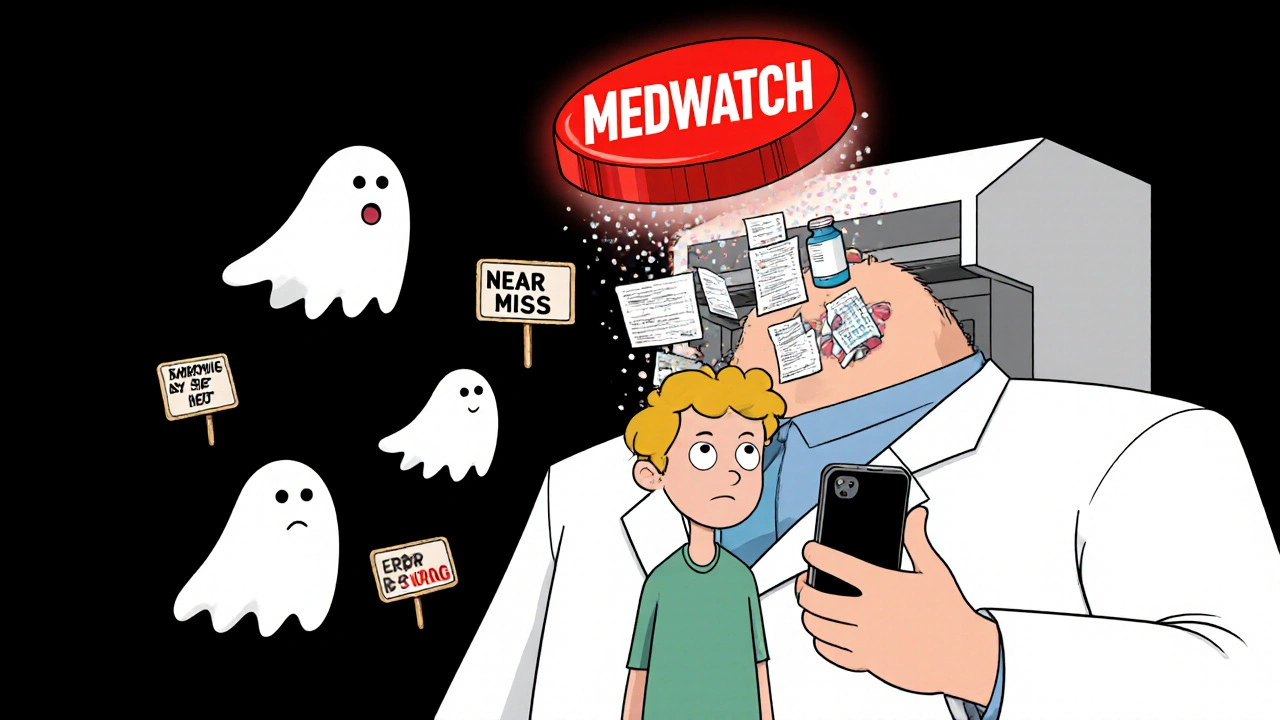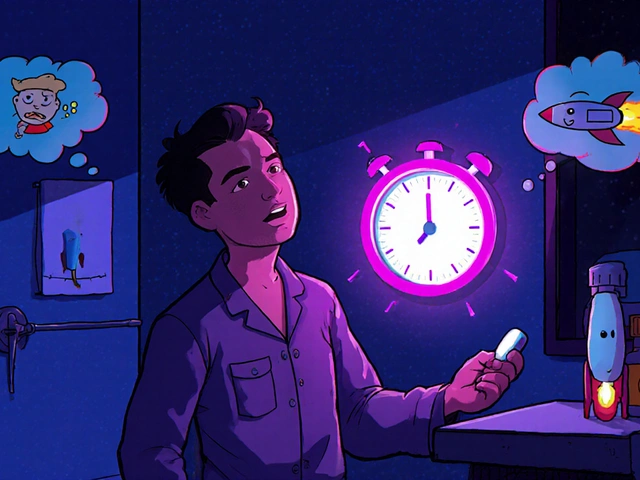Something doesn’t feel right. You took your pill at the right time, but your skin is breaking out, your stomach is cramping, or you’re suddenly dizzy when you weren’t before. Or maybe you opened your prescription bottle and the pills look different - smaller, a different color, no label. You’re not imagining it. This is a medication error, and you have the right - even the responsibility - to report it. Not just for yourself, but for everyone who might get the same wrong dose next week.
Most people don’t report medication errors. They assume it was their fault. Or they think no one will care. Or they’re afraid of sounding like they’re accusing their doctor. But here’s the truth: medication errors happen more often than you think. In the U.S. alone, about 1.3 million people are injured each year because of mistakes with prescriptions, doses, or timing. And the biggest reason these errors keep happening? They’re not being reported.
What Counts as a Medication Error?
A medication error isn’t just a doctor prescribing the wrong drug. It’s anything that goes wrong between when a medication is ordered and when it’s taken - and even after. That includes:
- Getting the wrong drug (like taking metformin instead of metoprolol)
- Wrong dose (10 mg instead of 5 mg)
- Wrong route (a pill meant to be swallowed, but given as an injection)
- Wrong timing (taking it twice in one day)
- Wrong patient (someone else’s medication ends up in your bottle)
- Missing or unclear labeling on the pill bottle
- A pharmacy giving you a drug you’re allergic to
- A nurse giving you a drug that wasn’t on your chart
Even if you didn’t get hurt, if you noticed something off - a mismatch between what you were told and what you got - that’s a near miss. And near misses are just as important to report. They’re the early warning signs.
Why Reporting Matters More Than You Think
Reporting isn’t about blaming someone. It’s about fixing systems. Hospitals and pharmacies use these reports to spot patterns. If five people in a week get the same wrong dose of insulin, that’s not bad luck - that’s a broken process. Maybe the label printer is glitching. Maybe the electronic system is confusing similar-sounding drug names.
When errors are reported and analyzed, repeat mistakes drop by up to 75%. That’s not theory - it’s data from the Agency for Healthcare Research and Quality. But only if people speak up.
And here’s something most don’t know: if you report a serious error to the FDA through MedWatch, they can trigger a nationwide drug recall. One patient in 2023 sent in a photo of her mislabeled blood pressure pills. Within three days, the FDA pulled the whole batch. That’s power.
Step-by-Step: How to Report a Medication Error
Here’s exactly what to do - no fluff, no jargon.
- Stop and assess. If you’re having a severe reaction - trouble breathing, swelling, chest pain - call emergency services immediately. Don’t wait to report. Your safety comes first.
- Gather evidence. Keep the pill bottle. Don’t throw it away. Take a photo of the label. If you have symptoms, take a picture of rashes, bruising, or swelling. Write down what you felt, when it started, and how it changed. Even small details matter - like ‘I felt shaky after 20 minutes’ or ‘the pill tasted bitter, unlike before.’
- Contact your provider. Call your doctor, pharmacist, or nurse line. Say clearly: ‘I believe I received the wrong medication or dose, and I’m concerned.’ Don’t say ‘I think I might have…’ - be direct. Ask: ‘Can we review my prescription record?’ Most providers have a patient safety line or form for this.
- Request your medical records. Under HIPAA, you’re legally entitled to your full records within 30 days. Request them in writing - email or letter. Include the date of the error, the medication name, and the pharmacy. If they delay, follow up every 48 hours. You’ll need these records to prove what was ordered versus what was given.
- Report to the FDA (MedWatch). Go to fda.gov/medwatch and fill out the online form. It now takes under 10 minutes. You’ll need: your name, the drug name, the error, your symptoms, and where you got the medication. You can report anonymously if you’re worried about backlash.
- Report to ISMP. The Institute for Safe Medication Practices runs a confidential reporting system for patients and providers. They don’t share names, and they turn reports into safety alerts. Visit ismp.org and click ‘Report an Error.’ This helps improve systems nationwide.

What If Your Provider Dismisses You?
This happens more than you’d expect. A 2022 study found 64% of patient reports were ignored unless backed by paperwork. If your doctor says, ‘That’s not possible,’ or ‘You must be mistaken,’ don’t back down.
Respond with: ‘I understand this may not be common, but here’s what I have - the bottle, my symptoms, and my records. I’d like to make sure this doesn’t happen to someone else.’ If they still refuse, ask to speak to the patient safety officer or hospital ombudsman. Most hospitals have one.
And if you’re in a clinic or small practice without a safety officer? Go straight to the FDA. Your report still counts. In fact, consumer reports are the only way many errors ever get seen by national regulators.
Special Cases: Schools and Care Homes
If the error happened in a school - your child got the wrong ADHD pill, or a nurse gave them insulin without an order - act fast. Schools are legally required to report medication errors within 24 hours in 48 U.S. states. But that doesn’t mean they will.
Write a formal letter to the school nurse and principal. Include: the date, time, medication, dose, symptoms, and what was done. Demand a written response. If you don’t get one in five days, contact your state’s department of education. They track these incidents.
For care homes or nursing facilities, report to both the facility’s administrator and your state’s long-term care ombudsman. These offices investigate abuse and neglect - and medication errors count.
What Happens After You Report?
Don’t expect a phone call from your doctor saying, ‘Thanks for letting us know.’ Most of the time, you won’t hear back. That’s frustrating - but it doesn’t mean nothing happened.
When you report to the FDA or ISMP, your info goes into a national database. Analysts look for clusters. If 10 people report the same error with the same batch of pills, the FDA investigates. If a hospital sees three errors in one month with the same nurse, they retrain staff.
And if you reported through your provider? They’re required to document it internally. That record stays with your chart. If you ever need to sue for negligence, that report becomes critical evidence.
Myths About Reporting - Debunked
- Myth: Reporting will get me labeled as a ‘difficult patient.’
Truth: Providers who value safety welcome reports. Those who don’t? You don’t want them managing your care anyway. - Myth: I’ll get sued if I report a mistake I made.
Truth: If you’re a patient, you can’t be sued for reporting an error. If you’re a provider, ‘just culture’ policies protect those who report in good faith. Blame doesn’t fix systems - transparency does. - Myth: It’s too late to report if it happened months ago.
Truth: The FDA accepts reports anytime. Even old errors help spot long-term patterns.
What You Can Do Right Now
You don’t need to wait for a crisis. Here’s how to prevent errors before they happen:
- Always check your prescription label against the name your doctor gave you.
- Ask your pharmacist: ‘Is this the same as last time?’
- Keep a written list of every medication you take - including doses and times.
- Use one pharmacy for all prescriptions. It helps catch dangerous interactions.
- Set phone reminders for doses - especially if you take multiple meds.
Medication safety isn’t just the job of doctors and pharmacists. It’s a team sport. And you’re the most important player - because you’re the one who takes the pill. If something feels wrong, speak up. Your voice could save a life.
What should I do if I think I got the wrong medication?
Stop taking the medication immediately. Call your doctor or pharmacist to confirm if it’s correct. Keep the bottle and take a photo of the label. Write down any symptoms you’re experiencing. Then, report the error to your provider and submit a report to the FDA’s MedWatch program. Even if you’re unsure, it’s better to report than to assume it’s fine.
Can I report a medication error anonymously?
Yes. When reporting to the FDA’s MedWatch program or the Institute for Safe Medication Practices (ISMP), you can choose not to provide your name. Your report will still be entered into the national database and used to improve safety systems. However, if you want a response or follow-up, providing contact information helps.
How long do I have to report a medication error?
There’s no strict deadline for patients reporting to the FDA or ISMP - you can report weeks or even months later. But for internal hospital or pharmacy reports, most require submission within 24 to 72 hours. For school or nursing home errors, reporting should happen within 24 hours by law in most states. The sooner you report, the more likely it is to prevent another incident.
Will reporting a medication error affect my relationship with my doctor?
If your provider has a culture of safety, they’ll appreciate your vigilance. If they react negatively, that’s a red flag. Research shows that non-punitive reporting cultures improve care quality and reduce errors. A provider who punishes patients for speaking up isn’t the kind you want managing your health. Consider finding a new provider who values transparency.
What’s the difference between reporting to my provider and reporting to the FDA?
Reporting to your provider helps fix the problem locally - maybe your pharmacy made a mistake, or your doctor’s system glitched. Reporting to the FDA helps fix it nationally. If the same error happens in 10 different states, the FDA can issue a recall, update labeling rules, or require new safety checks. Both are important. Use both.
Next Steps: Protect Yourself and Others
Don’t wait for another mistake to happen. Print this guide. Keep a copy in your wallet. Add the MedWatch website to your phone bookmarks. Talk to your family about medication safety. If you’re helping an elderly parent or a child with special needs, make sure they know how to spot a wrong pill.
Medication errors are preventable. But only if people speak up. Your report doesn’t just fix your story - it changes the system for everyone else.”




Levi Hobbs
November 17, 2025 AT 09:00I’ve had this happen twice-once with a wrong dose of metoprolol, another time with a pill that looked like candy. I took a photo, called my pharmacist, and they apologized and replaced it immediately. But here’s the thing: they didn’t report it internally. I had to push. So I filed a MedWatch report. Took 8 minutes. No one called me back. But I sleep better knowing someone’s seeing it.
henry mariono
November 18, 2025 AT 09:26Just wanted to say thanks for this. I didn’t know you could report anonymously. My mom had a bad reaction last year, and we were too scared to say anything. Now I’m going to file the report for her. She doesn’t even know how to use a computer. But I can do it for her.
Sridhar Suvarna
November 18, 2025 AT 13:55From India where pharmacy errors are rampant and nobody cares. I once got blood pressure pills labeled as diabetes meds. I didn't report because I thought no one would listen. But this post changed my mind. I'm sending the photo to ISMP right now. If we don't speak up nothing changes. Thank you for the clarity.
Joseph Peel
November 19, 2025 AT 16:15Excellent breakdown. I appreciate the distinction between local reporting and national systems like MedWatch. Too many people conflate the two. Also, the emphasis on documentation is spot-on. HIPAA rights are underutilized. I’ve seen patients give up after one dismissive response. This guide should be mandatory reading for anyone on chronic medication.
Kelsey Robertson
November 20, 2025 AT 08:56Ugh. Another feel-good, virtue-signaling post. You act like reporting is some noble act of heroism-but most of these errors are minor, and the system is already drowning in noise. And why should I trust the FDA? They approved opioids for years. You’re not saving lives-you’re just feeding your own sense of moral superiority.
Joseph Townsend
November 20, 2025 AT 18:06Bro. I took a pill once that tasted like burnt plastic. I freaked out. Took a selfie with the bottle. Sent it to my doctor. Got a call back at 2 a.m. They were like, ‘Oh my god, we had a batch recall last week-your bottle was mislabeled.’ I didn’t know I was part of a national alert until I saw the news. I felt like a superhero. And now I tell everyone: if it tastes weird, don’t swallow it. Take a picture. And report it. Like, now. Don’t wait.
Bill Machi
November 20, 2025 AT 22:21Who cares? This is why America is falling apart. People are too lazy to read the label. If you can’t tell the difference between a blue pill and a white pill, maybe you shouldn’t be taking medication at all. This isn’t a crisis-it’s a parenting failure. Stop blaming doctors. Teach people to read.
Elia DOnald Maluleke
November 22, 2025 AT 05:15In South Africa, we have no pharmacy oversight. I once received antibiotics meant for a cow-yes, a cow. The label was in Afrikaans, the dosage was in milligrams per kilogram, and I was told, ‘It’s the same thing.’ I didn’t report because I feared retaliation. But this piece… it gave me courage. I have sent the photo to ISMP. I am not alone. We are not powerless. The system may be broken-but our voices are the needle that mends it.
satya pradeep
November 24, 2025 AT 04:08Yo this is gold. I work in a clinic and we had a kid get the wrong ADHD med last month. We caught it because the mom asked if it looked different. We fixed it, but we didn’t report it. Now I’m gonna file it. Also, I always tell patients: if your pill tastes like chalk, it’s probably wrong. Don’t be shy. Just say it. We ain’t mad. We just need to know.